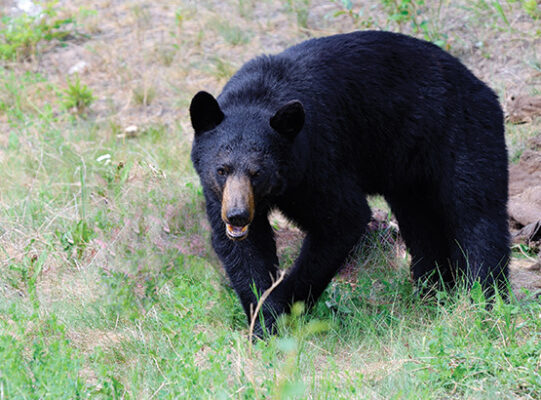Living with Bears: Things You Need to Know
The black bear is the only bear species still found in Arizona. It is the smallest and most widely distributed North American bear. It lives in most forest, woodland and chaparral habitats, and desert riparian areas. Black bears generally roam an area of 7 to 15 square miles.

living with bears
Bears and humans are sharing more of the same habitats as development occurs throughout Arizona. This close contact puts both humans and bears at risk. Even though bears have a cute and cuddly image, they can be dangerous. Conflicts between humans and bears are preventable.
-Fur color varies, including black, brown, cinnamon, and dark blond
-Weighs 125-400 pounds in Arizona with males being larger than females
-3 to 3 ½ feet tall when on all four feet
-5 to 6 feet long, with a short, inconspicuous tail
-Produces 2 to 3 cubs between Dec. and early Feb.
-Lives up to 25 years in the wild
-Most active at dawn and dusk (crepuscular)
-Eats primarily acorns, berries, insects, and cactus fruits
-Signs of activity include large tracks with claw marks (the hind print is somewhat like a human’s footprint), somewhat round droppings, digging, large overturned rocks and logs, and garbage from dumpsters or cans scattered good distances
-Threatened or stressed adults will make sounds, including woofing, hissing, popping of teeth, and grunting
Possible conflicts with humans and pets
Conflicts associated with black bears include public safety concerns and possible property damage. Most conflicts are the result of people unintentionally feeding bears, most often by allowing them access to household/campsite garbage or bird feeders. They raid dumpsters, garbage cans, grills, and campsites looking for an easy meal. They might enter a building by breaking screen doors and windows to look for food they smell. Although uncommon, black bear attacks on humans occasionally occur, especially in areas where they come into frequent contact with people and their food.
In the fall, bears must consume about 20,000 calories each day to store enough fat to last through the winter season when food is more scarce.
Living with bears – brochure
Wildlife managers face tough decisions in human-bear conflicts






what attracts them?
Bears may visit areas of human use because they find food. Food can include unsecured garbage, birdseed, pet food, fruit trees and some gardens. Drought, wildfire, and urban development can cause bears to roam farther in search of new food sources. Young bears sometimes travel long distances in search of an area not already occupied by another bear.
What should I do?
Black bears should always be considered unpredictable and potentially dangerous. A black bear will usually detect you and leave the area before you notice, unless the bear has been conditioned to people and their food. If you live in black bear country, take responsibility for not attracting them. Always work with your neighbors to achieve a consistent solution to the problem situation, and keep in mind that doing a combination of things is better than doing just one.
if you see a bear, or it approaches you
- Alter your route to avoid a bear in the distance.
- If the bear approaches, make yourself as large and imposing as possible. Stand upright and wave your arms, jacket or other items. Make loud noises, such as yelling, whistles, and banging pots and pans.
- Do not run and never play dead.
- Give the bear a chance to leave the area.
- If the bear does not leave, stay calm, continue facing it, and slowly back away.
- If a bear is in your yard, scare it away from inside the house, keeping the door closed.
in an emergency
Black bears usually avoid people, but if they start to associate people with food they may become aggressive. On the rare occasion that a black bear becomes aggressive, do the following
- If a black bear attacks, fight back with everything in your power – fists, sticks, rocks, and E.P.A. registered bear pepper spray.
- Arizona Game and Fish Department personnel remove bears that present an imminent threat to human safety or when they are in a situation where they cannot safely escape on their own. Call 911 and Arizona Game and Fish Department Dispatch at 623 236-7201. Dispatcher is available for your call 24 hours a day, 365 days a year.
removal is a last resort
Bears can be common at high elevations where food is plentiful. Bears that must be removed are relocated, or may be euthanized if they are considered too dangerous, have lost their fear of humans, or continue to get into conflicts with people. Following removal or relocation, the homeowner might experience more problems from a different bear if the original attractant is not eliminated. Relocating a bear is traumatic for the animal and does not guarantee it will live. Some are killed by bigger, older bears that already live in the relocation area. Removal usually can be prevented. If you live in black bear country, take responsibility for not attracting them. Follow the tips below to allow bears and humans to coexist while avoiding negative interactions.
To prevent further problems
- Don’t feed or give water to black bears. Be aware that human behaviors, such as feeding other animals, can attract black bears.
- Feed your pets inside or remove uneaten pet food between feedings, and remove garbage regularly or store in secure buildings.
- Place trash containers outside at the last possible time on the day of pickup.
- Hang bird feeders at least 10 feet above ground and away from buildings, including porches, and use a tray to catch spills. Discontinue feeding if a bear is in the area.
- Remove brush and cover around homes and corrals, creating a 50-yard barrier, to reduce hiding cover and resting places.
- Clean barbecues and store in a secure area.
- Clean up food and garbage around campsites, and never bring food, drinks, or anything that smells like food (deodorant, lotion, soap, shampoo, etc.) into your tent.
- Bears are good climbers, so to reduce a bear’s ability to get over a fence, it should be at least 6 feet tall and constructed of non-climbable material.
possible health concerns
Canine distemper — This viral disease consists of fever, loss of appetite, coughing, and eye and nose discharge.
laws and policies
- Black bears are top-level predators capable of killing or seriously injuring humans, and the department is committed to public education to help people learn how to behave responsibly and live safely in proximity to bears.
- Black bears are classified as big game animals. They may not be killed without a valid hunting license except in self-defense or where livestock has been killed. See Arizona Game and Fish Department Hunting Regulations.
- State law prohibits discharging a firearm, bow/arrow, or crossbow within a quarter-mile of an occupied residence or building without the permission of the owner.
- Check your local city ordinances, but most cities ban shooting firearms within city limits. Some cities ban the use of slingshots, BB guns, air guns, or bows.
additional resources
Want to Get Involved with Wildlife Conservation?
Volunteer your time, or donate to help us with conserving and protecting our wildlife. When you purchase a hunting or fishing license online, resources go back into wildlife conservation.
donate to wildlife conservation
With your help, we can continue to conserve & protect Arizona’s wildlife.
volunteer for projects
If you have a passion for wildlife and want to help us conserve and protect it, we’d love to have you on our team!

